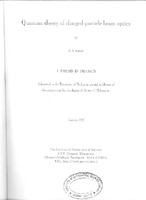- DSpace Home
- →
- IMSc Theses/ Dissertations
- →
- IMSc Theses/ Dissertations
- →
- View Item
JavaScript is disabled for your browser. Some features of this site may not work without it.
| dc.contributor.author | Khan, S. A. | |
| dc.date.accessioned | 2009-08-17T08:47:00Z | |
| dc.date.available | 2009-08-17T08:47:00Z | |
| dc.date.issued | 2009-08-17T08:47:00Z | |
| dc.date.submitted | 1997 | |
| dc.identifier.uri | https://dspace.imsc.res.in/xmlui/handle/123456789/75 | |
| dc.description.abstract | This thesis is an elaboration of Jagannathan's new formalism of the quantum theory of charged-particle beam optics with illustrations of applications to several practically important systems. Quantum mechanics of the optics of charged-particle beams transported through an electromagnetic lens or other such optical systems is analyzed, at the level of single particle dynamics, treating the electromagnetic fields as classical and disregarding the radiation aspects, using essentially as algebraic approach. The formalism is based on the basic equations of quantum mechanics appropriate to the situations. Quantum theory at the scalar level gives rise to interesting small additional contributions to the classical paraxial and aberrating behaviours. These contributions are directly proportional to powers of de Broglie wavelength. Further the Dirac theory gives spinor contributions which are also directly proportional to de Broglie wavelength. The classical, or geometrical, charged particle optics is obtained in the classical limit of the quantum theory as should be. The formalism based on the Dirac theory is further applied to the study of the Spin-Dynamics of a Dirac particle with anomalous magnetic moment being transported through a magnetic optical element. This leads to an unified treatment of both the orbital and spin motions. This is illustrated, by computing under the paraxial approximation, the transfer maps for the Phase-Space and spin components in the cases of the normal and skew magnetic quadrupole lenses. The quantum mechanics of the concept of spin-splitter devices, proposed recently for achieving polarized beams is understood using the formalism. An alternate approach to the quantum theory of charged particle-beam optics based on the Wigner phase-space distribution function is presented in brief. The possibility of extension of an approach to the Dirac, or the Spinor case is noted. Some interesting observations are listed and pointing out a few directions for future research. | en_US |
| dc.publisher.publisher | ||
| dc.subject | Quantum Theory | en_US |
| dc.subject | Spin Dynamics | en_US |
| dc.subject | Particle Physics | en_US |
| dc.subject | Classical Quantum Mechanics | en_US |
| dc.title | Quantum theory of charged particle beam optics | en_US |
| dc.type.degree | Ph.D | en_US |
| dc.type.institution | University of Madras | en_US |
| dc.description.advisor | Jagannathan, R. | |
| dc.description.pages | viii; 172p. | en_US |
| dc.type.mainsub | Physics | en_US |
Files in this item
This item appears in the following Collection(s)
-
IMSc Theses/ Dissertations
IMSc Theses/ Dissertations
